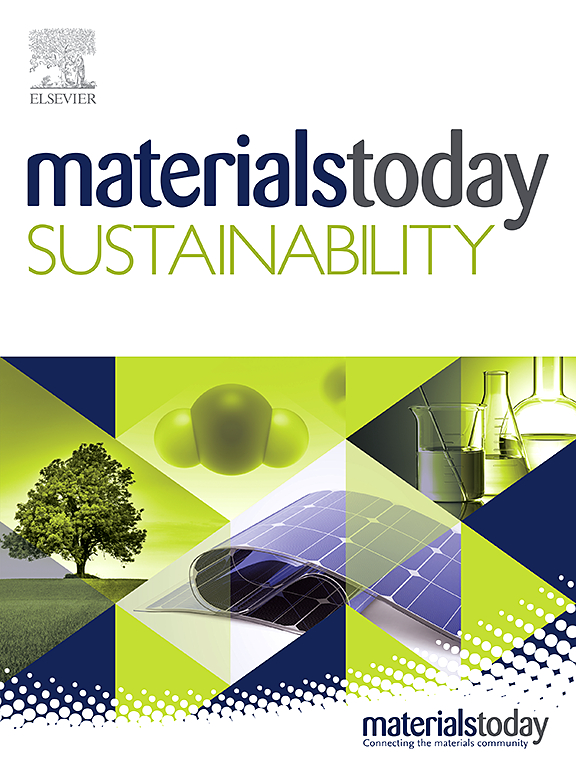Integrating reductive and photocatalytic nanomaterials: Mechanistic insights into the selective adsorption and degradation of cationic contaminants in aqueous environments
IF 7.9
3区 材料科学
Q1 GREEN & SUSTAINABLE SCIENCE & TECHNOLOGY
引用次数: 0
Abstract
Water pollution from industrial discharges and design of sensitive engineering systems surge the need for effective, selective and sustainable remediation technologies. This study investigates the efficacy of nano zero-valent iron (nZVI) versus various photocatalytic nanoparticles (NPs), including titanium dioxide (TiO2), magnesium oxide (MgO), zinc oxide (ZnO), and cerium oxide (CeO2) in removing the cationic dye of methylene blue (MB) from water systems. Photocatalytic nanoparticles offer potential advantages due to their high reactivity under UV light, which can degrade complex organic molecules through oxidation processes, whereas nZVI is recognized for its reductive and environmentally friendly capabilities. Here, the interaction dynamics of these NPs with MB was investigated. Briefly, the adsorption rates, degradation efficiency, and the influence of physical and chemical properties on the removal of MB was studied. The interaction mechanism was elucidated by UV–Vis, Dynamic Light Scattering (DLS), Transmission Electron Microscopy (TEM), and Fourier Transform Infrared Spectroscopy (FTIR). The results showed while nZVI is an effective reducing adsorbent, it struggles with the stable structure of MB. In a similar response to nZVI, MgO demonstrated superior adsorption capabilities compared to other NPs by over 4 mg/g MB adsorption. The findings suggest that the choice between photocatalytic NPs and nZVI should consider the specific nature of the contaminants and the desired pathway (oxidative vs. reductive) for their removal. This research highlights the importance of engineering nanoparticle applications in water treatment processes. It provides insights into the mechanisms that govern the interaction between NPs and cationic contaminants, crucial for designing more efficient water purification systems.
整合还原性和光催化纳米材料:在水环境中选择性吸附和降解阳离子污染物的机理
工业排放造成的水污染和敏感工程系统的设计使对有效、有选择性和可持续的补救技术的需求激增。本研究考察了纳米零价铁(nZVI)与各种光催化纳米颗粒(NPs),包括二氧化钛(TiO2)、氧化镁(MgO)、氧化锌(ZnO)和氧化铈(CeO2)在水中去除阳离子染料亚甲基蓝(MB)的效果。光催化纳米颗粒具有潜在的优势,因为它们在紫外光下具有高反应性,可以通过氧化过程降解复杂的有机分子,而nZVI则以其还原性和环保性而闻名。本文研究了这些NPs与MB的相互作用动力学。简要地研究了吸附速率、降解效率以及理化性质对MB去除的影响。通过紫外可见光谱(UV-Vis)、动态光散射(DLS)、透射电镜(TEM)和傅里叶变换红外光谱(FTIR)等手段对其相互作用机理进行了分析。结果表明,虽然nZVI是一种有效的还原性吸附剂,但它与MB的稳定结构相冲突。在与nZVI相似的反应中,MgO表现出比其他NPs更优越的吸附能力,吸附量超过4 mg/g MB。研究结果表明,在光催化NPs和nZVI之间的选择应该考虑污染物的特定性质和所需的去除途径(氧化还是还原)。这项研究突出了纳米颗粒在水处理过程中的工程应用的重要性。它提供了对控制NPs和阳离子污染物之间相互作用的机制的见解,这对于设计更有效的水净化系统至关重要。
本文章由计算机程序翻译,如有差异,请以英文原文为准。
求助全文
约1分钟内获得全文
求助全文
来源期刊

Materials Today Sustainability
Multiple-
CiteScore
5.80
自引率
6.40%
发文量
174
审稿时长
32 days
期刊介绍:
Materials Today Sustainability is a multi-disciplinary journal covering all aspects of sustainability through materials science.
With a rapidly increasing population with growing demands, materials science has emerged as a critical discipline toward protecting of the environment and ensuring the long term survival of future generations.
 求助内容:
求助内容: 应助结果提醒方式:
应助结果提醒方式:


